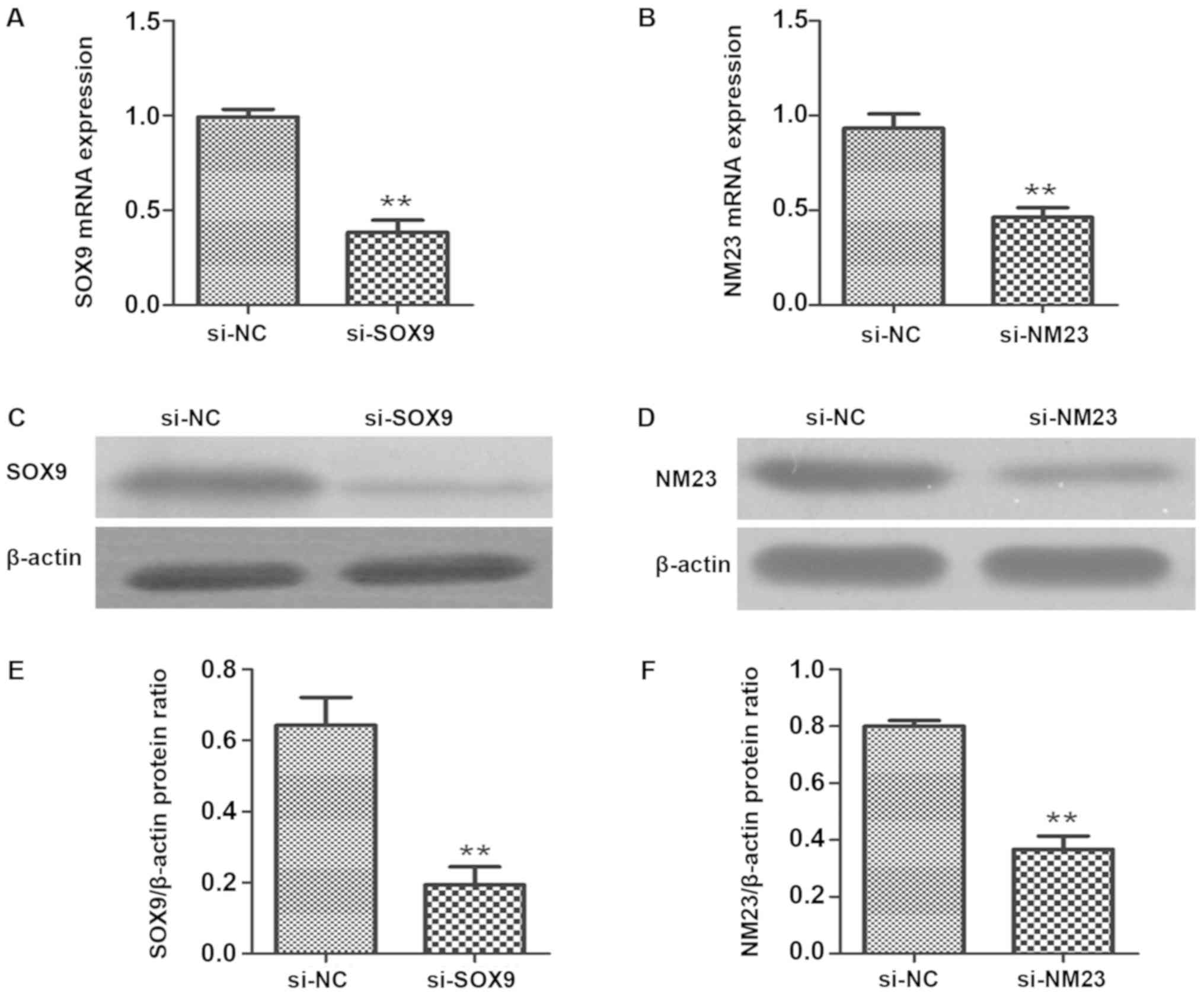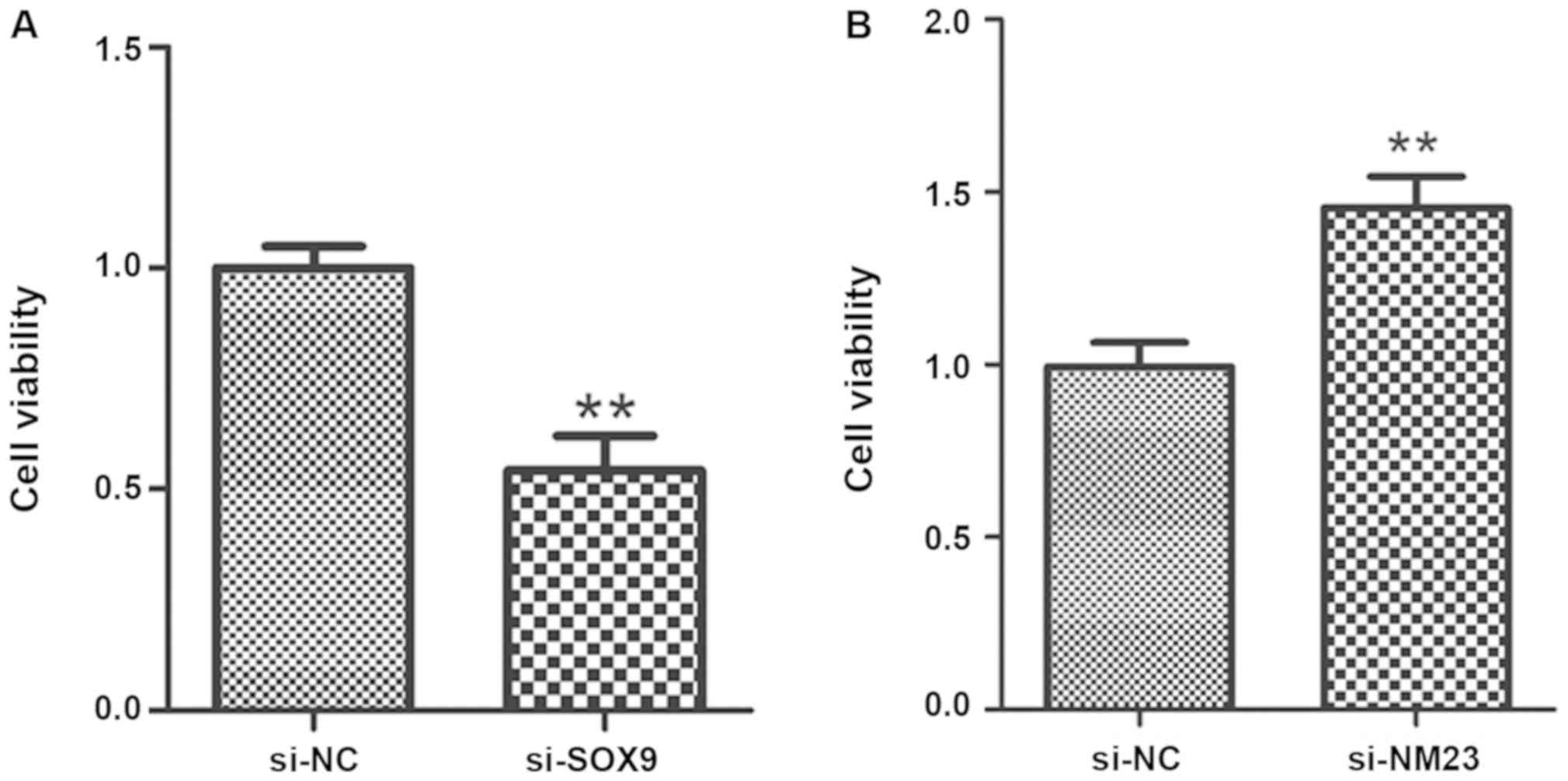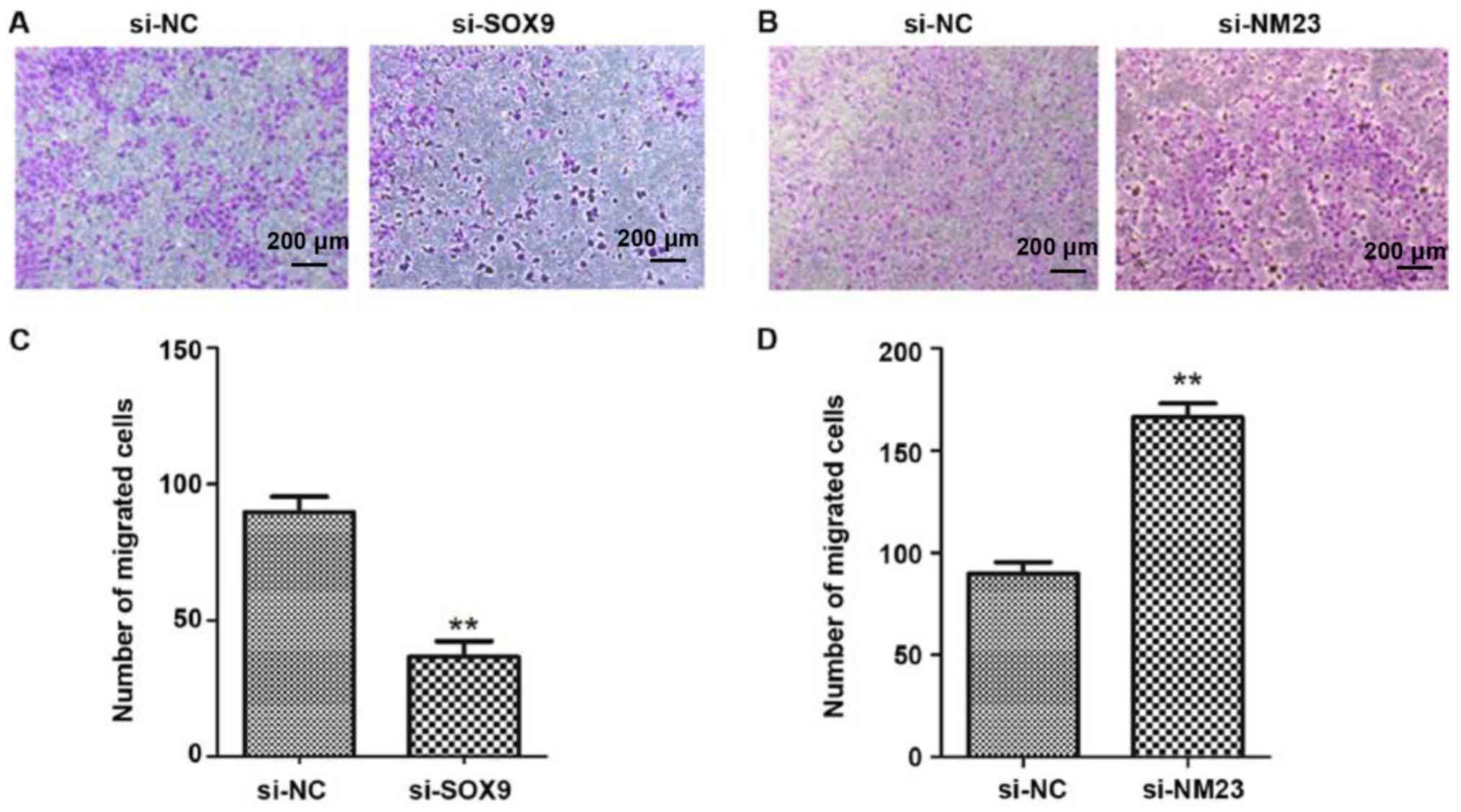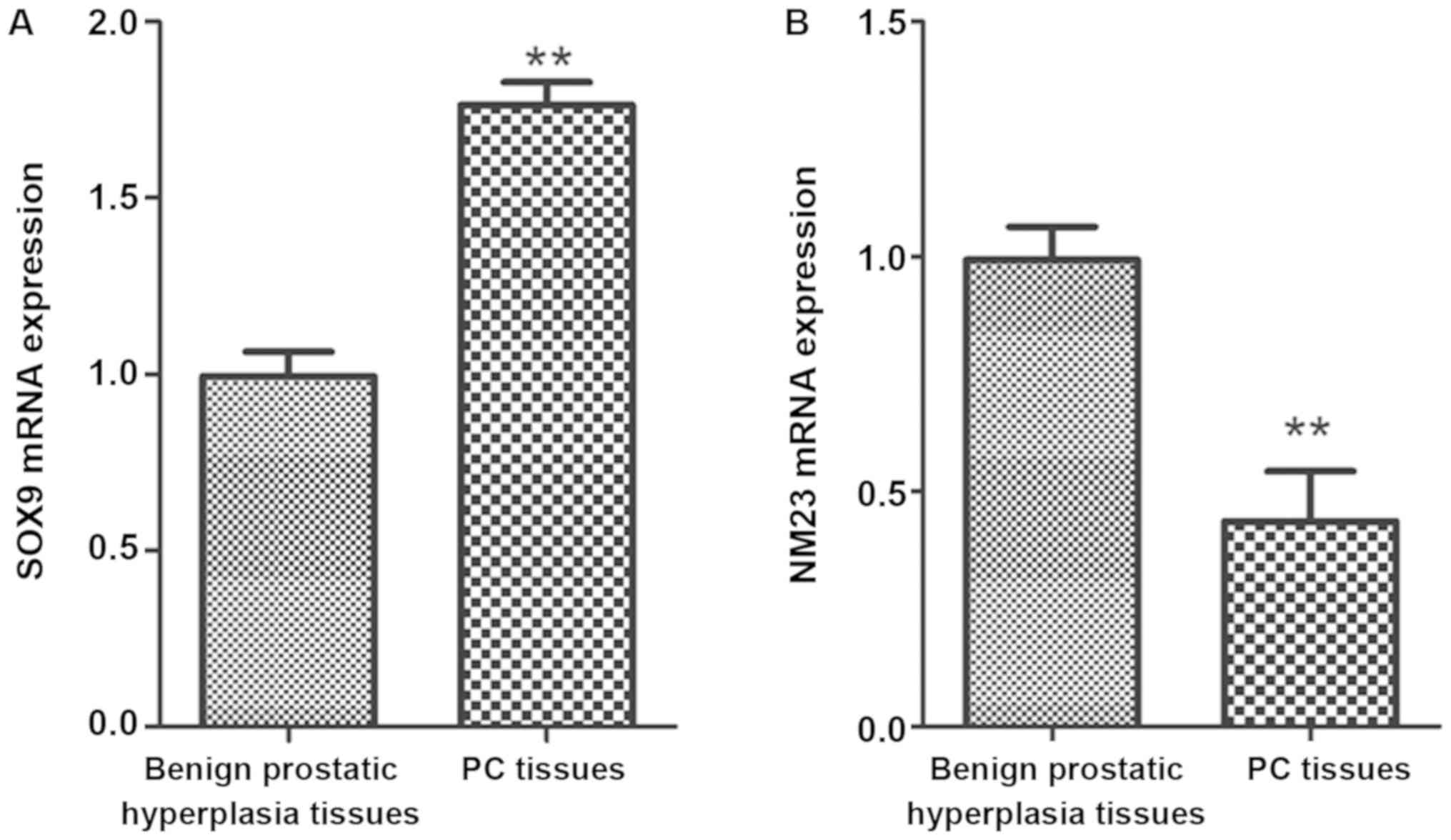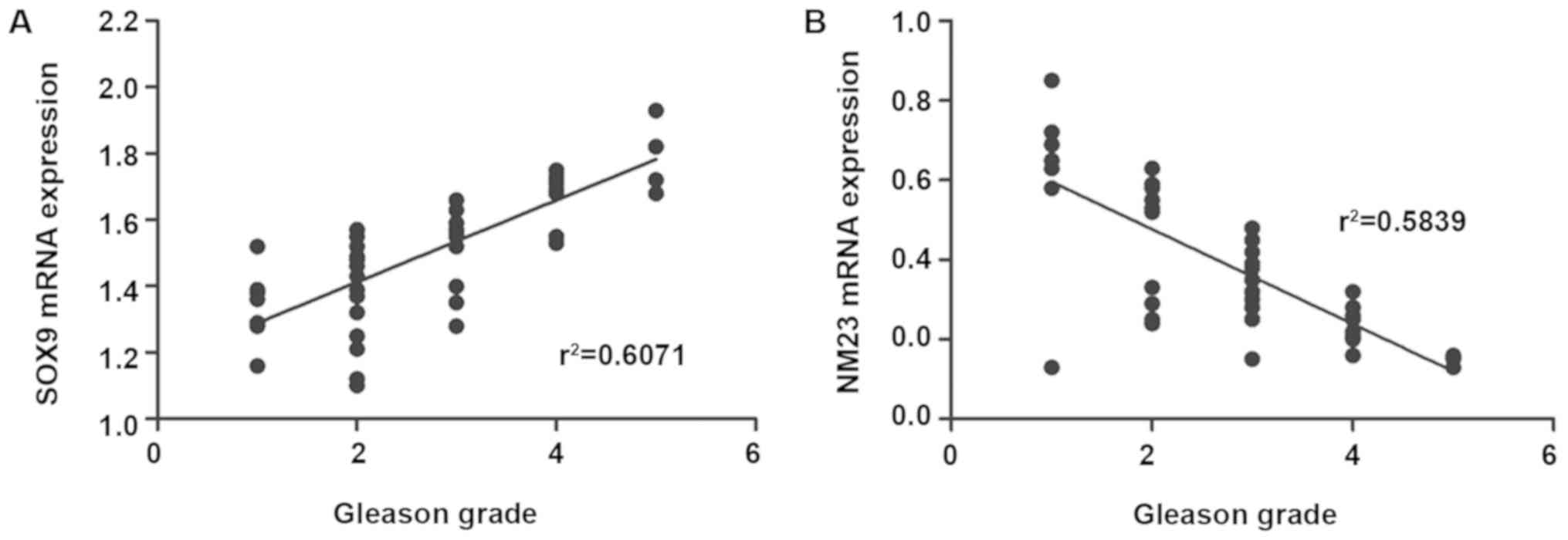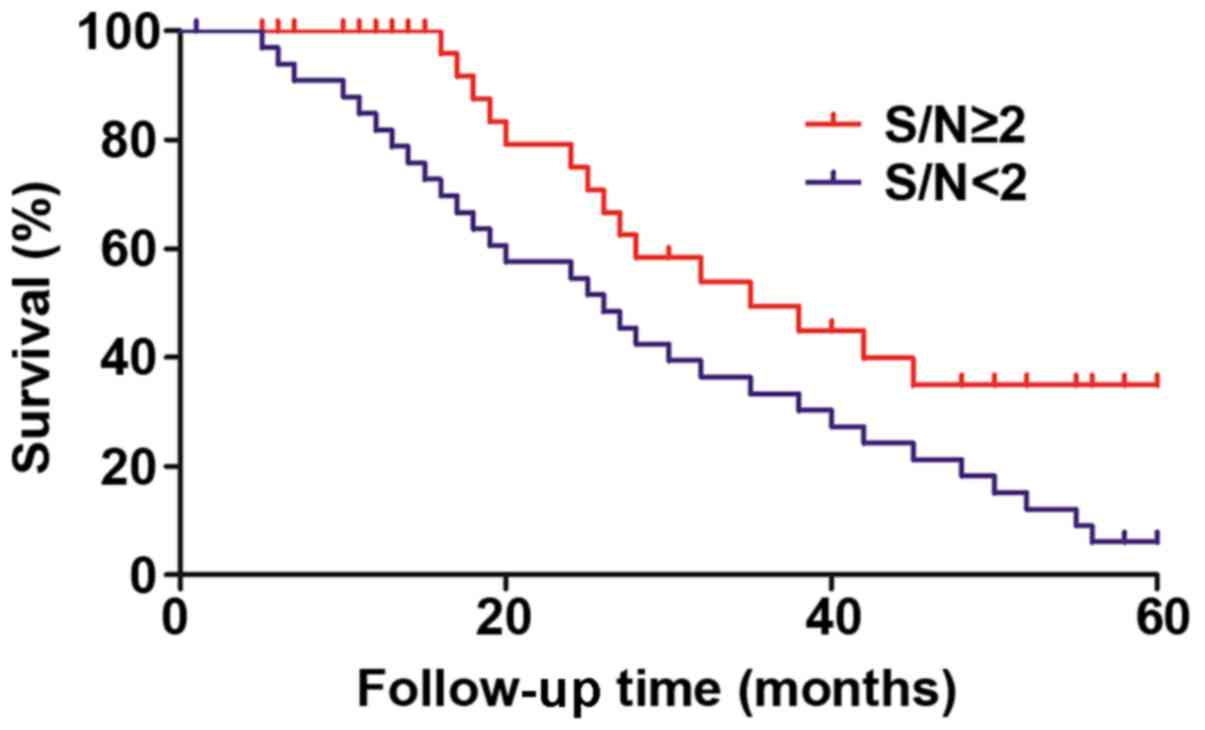Correlation of SOX9 and NM23 genes with the incidence and prognosis of prostate cancer
Retraction in: /10.3892/ol.2024.14324
- Authors:
- Published online on: December 12, 2018 https://doi.org/10.3892/ol.2018.9828
- Pages: 2296-2302
-
Copyright: © Xi et al. This is an open access article distributed under the terms of Creative Commons Attribution License.
Abstract
Introduction
Prostate cancer (PC), a common urological tumor, is the most common tumor among men in Western countries, and its mortality rate after onset ranks second only to lung cancer. With the prolongation of human life expectancy, the incidence rate of PC in China is increasing year by year, and PC has become one of the important diseases threatening the health of elderly men (1). PC tends to cause obstruction of the urethra and dysuria. Twenty years ago, it was difficult to diagnose the disease, and it could be diagnosed only when urinary retention and generalized osteopenia occurred (2). With the development of molecular biology techniques, prostate-specific antigen (PSA), as a screening tool for PC, can remarkably increase the detection rate in patients (3). However, since the specificity, sensitivity and false-negatives of PSA cannot be detected at the same time, PC can be definitely diagnosed through repeated confirmation by PSA, thus resulting in significant costs for both patients and the medical staff. Thus, more auxiliary examinations and indicators are needed for the diagnosis of PC (4). A large amount of research evidence has indicated that sex determining region Y-box (SOX) family genes are closely related to various tumors (5,6). SOX9 is a SOX family gene that has been mostly and thoroughly studied. Qin et al (7) have found that SOX9 plays important roles in the differentiation and proliferation of mouse prostate, and upregulation of SOX9 leads to a significant decrease in cell differentiation rate. At the same time, Wang et al (8) have ascertained that SOX9 gene can regulate the occurrence and recurrence of PC in mice through the Wnt/β-catenin pathway. NM23 gene is a complementary deoxyribonucleic acid (cDNA) isolated from a mouse melanoma cell line and has been confirmed to be closely related to the inhibition of tumor metastasis. NM23 plays a negative regulatory role in tumor metastasis (9). Tumor metastasis is an important indicator for tumor deterioration. Many studies have confirmed that low expression of NM23 in various tumors (melanoma, liver cancer and lymphoma) is associated with high metastasis potential and poor prognosis (10). Currently, there are few reports on the correlations of the expression of SOX9 and NM23 in PC with proliferation and migration abilities of PC cells, and their mechanisms are not yet clear.
In this study, the correlation of the incidence and prognosis of SOX9 and NM23 genes with PC was mainly investigated, and the effects of SOX9 and NM23 on the proliferation and migration abilities of PC were explored. In addition, the correlation of the expression levels of SOX9 and NM2 in PC patients with clinical stage and prognosis were analyzed. It is expected that SOX9 and NM23 will serve as clinically important genes for the diagnosis of PC.
Materials and methods
Materials
The following were purchased: human PC-3 cell line (cat. no. TCHu158; Shanghai Cell Bank of the Chinese Academy of Sciences); SOX9 and NM23 small interfering ribonucleic acid (siRNA), and negative siRNA (all from Shanghai GenePharma Co., Ltd., Shanghai, China); plasmid (Ambion; Thermo Fisher Scientific, Inc., Waltham, MA, USA); reverse transcription kit and quantitative polymerase chain reaction (qPCR) kit (both from Nanjing Vazyme Biotech Co., Ltd., Nanjing, China); RPMI-1640 and fetal bovine serum (both from Gibco; Thermo Fisher Scientific, Inc.); trypsin (Sigma-Aldrich; Merck KGaA, Darmstadt, Germany); Lipofectamine™ 2000 (Invitrogen; Thermo Fisher Scientific, Inc.); Transwell chamber (Corning, Inc., Corning, NY, USA); 3-(4,5-dimethylthiazol-2-yl)-2,5-diphenyltetrazolium bromide (MTT; Sigma-Aldrich; Merck KGaA); rabbit anti-human SOX9 monoclonal and NM23 polyclonal antibodies (cat. nos. 82630 and 3338; both from Cell Signaling Technology, Inc., Danvers, MA, USA). The rest of the reagents and instruments that are not listed are noted in the corresponding section of this study.
Research subjects and tissue samples
A total of 63 patients with PC (68.5±7.8 years old) and 56 patients with benign prostatic hyperplasia (65.2±11.6 years old), treated in the Department of Urology of Huadu District People's Hospital (Guangzhou, China) from March 2009 to March 2012, were enrolled. Tissue samples were obtained via transurethral resection of prostate (TURP). Samples were immediately stored in liquid nitrogen after removal. Inclusion criteria for PC patients: patients who were definitely diagnosed with PC via pathological examination of tissue sections and clinical diagnosis. Inclusion criteria for patients with benign prostatic hyperplasia: patients definitely diagnosed with benign prostate hyperplasia via pathological examination of tissue sections. Exclusion criteria: none of the selected cases suffered from other wasting diseases, had received any long-term androgen-related treatments or had received prostate digital rectal examination within 1 week before sampling. All the included patients had complete clinical treatment and pathological examination data. The study was approved by the Ethics Committee of Huadu District People's Hospital and written informed consents were signed by the patients or the guardians.
Gene transfection
After the siRNA transcription template DNA strand (Shanghai Bioengineering Co., Ltd., Shanghai, China) was designed and synthesized, SOX9 and NM23 expression vectors were constructed. Gene transfection was conducted for the selected positive clones after they were identified by sequencing: PC-3 cells in the logarithmic growth phase (cell population was adjusted to 1×106 cells/well) were selected and placed in an incubator for 24 h for further culture. After rewarming, 3 µl of siPORT-1 were taken and added with 597 µl medium (100 µl/well) for dilution, 20 min after which 1 µg plasmid was added. Subsequently, the cell culture plate was gently shaken and placed at room temperature for 20 min, and then the medium was discarded and replaced with new medium, followed by further culture in the incubator. Transfected cells were identified by 500 µg/ml G418 selective medium: the successfully transfected cells grew and reproduced, whereas the untransfected cells were all dead within a week.
Detection of changes in gene expression levels of SOX9 and NM23 by reverse transcription-quantitative polymerase chain reaction (RT-qPCR)
Successfully transfected cells were further cultured. When the cells grew to the logarithmic growth phase, they were transferred to a 6-well plate for further culture. When the cells reached 80–90% confluence, an appropriate amount of TRIzol (TRIzol kit; Thermo Fisher Scientific, Inc.) was added to the cell culture plate. An appropriate amount of TRIzol was added to the obtained PC specimen and prostate hyperplasia specimen in a ratio of 1 ml:100 mg. The cells and tissue samples were crushed by ultrasound in an ice bath and centrifuged at 4°C and 12,000 × g for 10 min, and the supernatant was extracted. A sufficient amount of chloroform was added in the supernatant in a volume ratio of 5:1, which was repeatedly shaken for 10 times, and incubated on ice for 5 min. After that, the cells were centrifuged at 4°C and 12,000 × g for 10 min, and the supernatant was extracted (the volume of the supernatant was appropriately reduced to avoid absorption into the sample in the middle layer). An equal volume of isopropanol was added to the supernatant, left to stand at room temperature for 10 min, and then centrifuged at 10°C and 10,000 × g for 10 min. The supernatant was discarded, 1 ml freshly prepared 75% ethanol was added for washing, and shaking was repeated. The sample was centrifuged at 4°C and 12,000 × g for 10 min. After discarding the supernatant and opening the lid, RNA was obtained after being dissolved in 30 µl diethylpyrocarbonate (DEPC)-treated water. The quality of the extracted RNA was verified via ultraviolet (UV) spectrophotometer (Bio-Rad Laboratories, Inc., Hercules, CA, USA) and agarose gel electrophoresis, respectively. cDNA synthesis and reverse transcription were carried out using the HiScript® II 1st Strand cDNA Synthesis kit (Nanjing Vazyme Biotech Co., Ltd.). The manufacturer's instructions were strictly followed for the operation and formulation of the reaction system. The RT-qPCR amplification was performed using the SYBR ExScript™ RT-PCR kit (Takara Biotechnology Co., Ltd., Dalian, China) in strict accordance with the manufacturer's instructions. The primers were synthesized by Invitrogen (Thermo Fisher Scientific, Inc.) and the sequences are shown in Table I. RT-qPCR reaction conditions were set as follows: at 94°C for 2 min, 94°C for 60 sec, 62°C for 25 sec and 72°C for 25 sec for a total of 40 cycles. Amplification was performed on the qRCR instrument with β-actin as an internal reference. The relative expression level of the relevant gene messenger RNA (mRNA) was calculated with 2−ΔΔCq (11).
Detection of the expression levels of SOX9 and NM23 proteins via western blotting
When the cells reached 80–90% confluence, they were extracted. A total of 1 ml radioimmunoprecipitation assay (RIPA) lysis buffer and 1% protease inhibitor were added to extract nuclear proteins. The loading sample system at equal concentration was prepared after protein quantification and placed at 95°C (boiling) for 15 min to denature proteins. Separation gels (15%) and spacer gels (15%) were configured and loaded with 8 µl protein solution per lane. At the end of the electrophoresis, the proteins were transferred onto the PVDF membrane at a constant current of 260 mA for 90 min. Freshly prepared 5% skim milk powder was used for blocking for 2 h. The protein bands were cut according to the molecular size. The primary rabbit anti-human SOX9 and NM23 antibodies (1:1,000) were incubated overnight at 4°C, followed by membrane washing 3 times via Tris-buffered saline with Tween-20 (TBST) (5 min each time). The goat anti-rabbit polyclonal secondary antibody (1:2,000; cat. no. 7074; Cell Signaling Technology, Inc.) was added and incubated at 20°C for 1 h, and the membrane was washed with TBST 3 times (5 min each time). Freshly prepared ECL fluid (EMD Millipore, Burlington, MA, USA) was applied for color development in a dark room. Using β-actin as a control, the expression intensity was indicated by the ratio of the gray value of the target protein band to β-actin band and was analyzed via ImageJ software (National Institutes of Health, Bethesda, MD, USA).
Detection of cell proliferation by MTT
Successfully transfected cells were inoculated into a 96-well plate. The cell density was adjusted to 1×105 cells/well, with PC-3 cells transfected with empty vectors as control, to ensure the same number of inoculated cells. The cells were placed in an incubator for 24 h and 10 µl pre-configured MTT was added to each well. The culture medium was discarded after 4 h of continuous cultivation, and 150 µl DMSO was added. After shaking, the absorbance value of each well was measured with an enzyme immunoassay analyzer (570 nm; DKing Technology Co., Ltd., Chongqing, China), and the optical density (OD) was calculated, so as to evaluate the proliferation ability of the two groups of cells.
Detection of cell migration ability by Transwell assay
The migration ability of the cells was detected by the Transwell assay, using PC-3 cells transfected with empty vectors as control. The cell density was adjusted to 1×106 cells/ml. A total of 100 µl cell resuspension solution was added to the upper chamber, and 600 µl complete medium was added to each well of the lower chamber. The cells were placed in an incubator for 8 h for further culture. The Transwell chambers cleaned by phosphate-buffered solution (PBS) were placed in 24 wells. A total of 500 µl of formaldehyde was added for fixation for 20 min, and 500 µl 0.2% crystal violet was added to each well for staining for 20 min. Then, the number of cells permeating through the membrane and rinsed with PBS was calculated under a microscope. Eight fields of view were selected for statistics, and the average was calculated, which was considered as the number of cells that permeated through the filter membrane to evaluate the migration ability of the two groups of cells.
Gleason grading
After the cancerous tissues of PC patients were obtained, they were fixed with 10% formaldehyde, followed by dehydration, embedding, slicing, and hematoxylin and eosin (H&E) staining. The degree of tumor differentiation was evaluated and divided into 5 grades by Gleason grading: grade I, the tumors had clear boundaries with single existence, and the morphology of the tumor glands was consistent; grade II, the tumor had relatively clear boundaries and the size of the glands was inconsistent; grade III, the boundary between tumor and non-tumor was not clear, the two infiltrated each other, the size of the glands was obviously inconsistent, and there was a large acini; grade IV, the glands of the tumor fused with each other and their shapes were abnormal; grade V, tumor glands were solid masses with obvious necrosis. The correlations of the Gleason grade with the expression levels of SOX9 and NM23 genes of in tumor tissues in patients with PC were analyzed, and the correlations of SOX9 and NM23 genes with the incidence of PC were evaluated.
Survival analysis
Patients with PC were followed up for a period of 5 years, which was terminated in March 2017. The survival analysis was conducted with the ratio of SOX9/NM23 (S/N) gene expression as an ordinate (patients with S/N<2 were included in group A, and those with S/N≥2 were included in group B), and the correlations of SOX9 and NM23 genes with the prognosis of patients were evaluated.
Statistical analysis
Data in this study were expressed as mean ± standard deviation (SD), and Statistical Product and Service Solutions (SPSS) 19.0 software (IBM Corp., Armonk, NY, USA) was applied for data analysis. t-test was conducted for intergroup comparison. Homogeneity test of variance was conducted, and if the variance was homogeneous, the Bonferroni method was used. Pearson's correlation test was used for correlation analysis. The survival curves were plotted using the Kaplan-Meier method and the differences between them were examined using the log-rank test. P<0.05 was considered to indicate a statistically significant difference. Histograms were drawn via GraphPad Prism 5.0 software (GraphPad Software, Inc., La Jolla, CA, USA).
Results
Effects of SOX9-siRNA and NM23-siRNA on the expression levels of SOX9 and NM23 in cells
The expression levels of SOX9 and NM23 genes and proteins in the transfected cells were detected via RT-qPCR and western blotting. The results showed that compared with the transfection with empty vectors, the transfection with SOX9-siRNA could significantly reduce the expression of SOX9 gene and protein in PC-3 cells (P<0.01). The expression of NM23 gene and protein in PC-3 cells transfected with NM23 were markedly lower than those in PC-3 cells transfected with empty vectors (P<0.01) (Fig. 1).
Effects of SOX9 and NM23 genes on PC cell proliferation
PC-3 cells transfected with si-SOX9, si-NM23 and empty vectors, respectively, were seeded in 96-well plates, and cell proliferation was detected via MTT after 24 h of further culture. The results revealed that compared with that of PC-3 cells transfected with empty vectors, the proliferation ability of PC-3 cells transfected with si-SOX9 was obviously decreased (P<0.01), and this ability of PC-3 cells transfected with si-NM23 was remarkably higher than that of PC-3 cells transfected with empty vectors (P<0.01) (Fig. 2).
Effects of SOX9 and NM23 genes on cell migration ability
Transwell assay was adopted to test the migration ability of cells, which indicated that compared with the transfection with empty vectors, the low expression of SOX9 gene could obviously reduce the migration ability of PC-3 cells (P<0.01), while the low expression of NM23 gene could significantly increase the migration ability of PC-3 cells (P<0.01) (Fig. 3).
Expression of SOX9 and NM23 genes in PC tissues
The expression of SOX9 and NM23 genes was studied with benign prostatic hyperplasia tissues in PC patients as controls. The results revealed that the expression of SOX9 gene in PC tissues was obviously higher than that in benign prostatic hyperplasia tissues (P<0.01), while that of NM23 gene in the former was significantly lower than that in the latter (P<0.01) (Fig. 4).
Correlation of SOX9 and NM23 with PC clinical grade
Gleason grading was performed for the enrolled PC patients, and the correlations of the expression levels of SOX9 and NM23 genes in tumor tissues of patients with their Gleason grades were analyzed. The results revealed that SOX9 gene was positively correlated with the patient's Gleason grade (P<0.01, r2=0.6071), while NM23 gene was negatively associated with this grade (P<0.01, r2=0.5839) (Fig. 5).
Correlation of SOX9 and NM23 with the prognosis of patients
The 5-year follow-up was performed for the enrolled PC patients to evaluate the correlation of SOX9 and NM23 genes with the prognosis of patients. The results indicated that the survival time of patients with S/N≥2 was significantly longer than that of patients with S/N<2, and the difference was statistically significant (P<0.01, log-rank test) (Fig. 6).
Discussion
Normal prostate epithelial cells undergo certain morphological changes under the influence of various physiological and biochemical stimuli, and convert into prostatic epithelial sarcoma. When the cells further deteriorate, they evolve into PC (12). The development of molecular biology enables tumor markers to play important roles in the diagnosis and treatment of tumors. In clinical practice, the incidence of PC can be evaluated based on the concentration of PSA, which effectively improves the diagnosis rate of PC (13). However, due to the low specificity of PSA, multiple other tumors and diseases of the prostate may elevate PSA, so its use alone often results in false-positive results. Additionally, the existence of the linear relation between PSA and PC has not been reported, so the progression of the disease cannot be predicted (14). Gleason grading for PC patients can help with the prognosis of patients and effectively evaluate the therapeutic effect of PC, so it is an important reference for treatment regimens. Alexis and Worsley (15) have found that the Gleason grade is closely related to the clinical grade of PC patients, and there is also a correlation between the Gleason grade and 5-year incidence rate after treatment.
SOX9 is highly expressed in various tumors, such as melanoma, promotes proliferation and migration of tumor cells and reduces tumor cell apoptosis (16). At the same time, some researchers have used high-throughput tissue gene chips to screen highly expressed SOX9 gene in PC patients. The above indicate that SOX9 gene has a certain correlation with the incidence of PC (17). In this study, siRNA was applied to silence SOX9 gene in PC-3 cell line, which manifested that the proliferation and migration abilities of PC-3 cells were significantly reduced. Also, it was demonstrated that the expression of SOX gene in PC tissues was obviously higher than that in benign prostatic hyperplasia tissues. The results of this experiment and several previous studies on SOX9 gene in tumors strongly suggest that the SOX gene is associated with the incidence of PC. At the same time Gleason grading was conducted for PC patients, and the correlation analysis of the Gleason grade with SOX9 gene was performed. The results revealed that SOX9 gene was positively correlated with the patient's Gleason grade, suggesting that SOX9 gene is related to the prognosis of patients and can be used to evaluate the therapeutic effect and prognosis of PC patients.
NM23 gene encodes a diphosphate nucleoside enzyme, participates in the synthesis of nucleoside triphosphates and the processes of G protein-mediated cell proliferation and differentiation. A study (18) has illustrated that NM23 gene is closely associated with colon cancer metastasis and tumor migration. Besides, it is negatively correlated with the patient's clinical grade, and the proliferation ability of tumor cells in patients with NM23 negative expression is significantly higher than that in patients with NM23 positive expression. A large amount of research evidence has manifested that both NM23 gene and protein play an important role in inhibiting tumor metastasis. The low expression of NM23 is closely correlated with the metastasis and poor prognosis of lung cancer, melanoma, breast cancer and other tumors (19–21). The present study revealed that silencing NM23 gene in PC cells could lead to significant increases in the proliferation and migration abilities of PC cells, the expression of NM23 gene in tumor tissues of PC patients was found to be significantly higher than that in tissues of patients with benign prostatic hyperplasia, and at the same time it was negatively correlated with the patient's Gleason grade. The above study results indicate that NM23 can be used as an indicator for evaluating PC. At the same time, univariate analyses of the expression of SOX9 and NM23 genes in patients with PC and the patient's survival time were conducted, which demonstrated that patients with a high S/N ratio have a significantly lower 5-year survival rate than those with a low S/N ratio. However, the pathways through which SOX9 and NM23 genes influence PC cell proliferation and migration were not investigated in depth in this study. This will be the focus and direction of subsequent studies, which is of great significance in further revealing the correlations of SOX9 and NM23 genes with the incidence and prognosis of PC.
In conclusion, SOX9 and NM23 genes are closely related to the occurrence, development and prognosis of PC. It is of high clinical value to integrate the expression of SOX9 and NM23 genes into the diagnosis and treatment of PC patients.
Acknowledgements
Not applicable.
Funding
The study was funded by the Natural Science Foundation of Guangdong Province (2014A02021247) and Doctor's Foundation of Guizhou People's Hospital (GZSYBS[2015]07).
Availability of data and materials
The datasets used and/or analyzed during the present study are available from the corresponding author on reasonable request.
Authors' contributions
MX collected the tissue samples. SW assisted with gene transfection. MX and WH performed RT-qPCR. YZ and WJ were responsible for western blotting and MTT assay. JH contributed to Transwell assay. All authors read and approved the final manuscript.
Ethics approval and consent to participate
The study was approved by the Ethics Committee of Huadu District People's Hospital (Guangzhou, China) and written informed consents were signed by the patients or the guardians.
Patient consent for publication
Not applicable.
Competing interests
The authors declare that they have no competing interests.
References
|
Fang M, Nakazawa M, Antonarakis ES and Li C: Efficacy of abiraterone and enzalutamide in pre- and postdocetaxel castration-resistant prostate cancer: A trial-level meta-analysis. Prostate Cancer. 2017:85608272017. View Article : Google Scholar : PubMed/NCBI | |
|
Katreddy RR, Bollu LR, Su F, Xian N, Srivastava S, Thomas R, Dai Y and Wu B: Correction: Do psychological harms result from being labelled with an unexpected diagnosis of abdominal aortic aneurysm or prostate cancer through screening? A systematic review. BMJ Open. 8:e017565corr12018. View Article : Google Scholar : PubMed/NCBI | |
|
McClinch K, Avelar RA, Callejas D, Izadmehr S, Wiredja D, Perl A, Sangodkar J, Kastrinsky DB, Schlatzer D and Cooper M: Small molecule activators of protein phosphatase 2A for the treatment of castration-resistant prostate cancer. Cancer Res. 22:48–63. 2018. | |
|
Song XL, Huang B, Zhou BW, Wang C, Liao ZW, Yu Y and Zhao SC: miR-1301-3p promotes prostate cancer stem cell expansion by targeting SFRP1 and GSK3β. Biomed Pharmacother. 3:2185–2195. 2018. | |
|
Ma F, Ye H, He HH, Gerrin SJ, Chen S, Tanenbaum BA, Cai C, Sowalsky AG, He L, Wang H, et al: SOX9 drives WNT pathway activation in prostate cancer. J Clin Invest. 126:1745–1758. 2016. View Article : Google Scholar : PubMed/NCBI | |
|
Xie Y, Lu W, Liu S, Yang Q, Carver BS, Li E, Wang Y, Fazli L, Gleave M and Chen Z: Crosstalk between nuclear MET and SOX9/β-catenin correlates with castration-resistant prostate cancer. Mol Endocrinol. 28:1629–1639. 2014. View Article : Google Scholar : PubMed/NCBI | |
|
Qin GQ, He HC, Han ZD, Liang YX, Yang SB, Huang YQ, Zhou L, Fu H, Li JX, Jiang FN, et al: Combined overexpression of HIVEP3 and SOX9 predicts unfavorable biochemical recurrence-free survival in patients with prostate cancer. Onco Targets Ther. 7:137–146. 2014.PubMed/NCBI | |
|
Wang G, Lunardi A, Zhang J, Chen Z, Ala U, Webster KA, Tay Y, Gonzalez-Billalabeitia E, Egia A, Shaffer DR, et al: Zbtb7a suppresses prostate cancer through repression of a Sox9-dependent pathway for cellular senescence bypass and tumor invasion. Nat Genet. 45:739–746. 2013. View Article : Google Scholar : PubMed/NCBI | |
|
Carotenuto M, de Antonellis P, Chiarolla CM, Attanasio C, Damiani V, Boffa I, Aiese N, Pedone E, Accordi B, Basso G, et al: A therapeutic approach to treat prostate cancer by targeting Nm23-H1/h-Prune interaction. Naunyn Schmiedebergs Arch Pharmacol. 388:257–269. 2015. View Article : Google Scholar : PubMed/NCBI | |
|
Andolfo I, De Martino D, Liguori L, Petrosino G, Troncone G, Tata N, Galasso A, Roma C, Chiancone F, Zarrilli S, et al: Correlation of NM23-H1 cytoplasmic expression with metastatic stage in human prostate cancer tissue. Naunyn Schmiedebergs Arch Pharmacol. 384:489–498. 2011. View Article : Google Scholar : PubMed/NCBI | |
|
Livak KJ and Schmittgen TD: Analysis of relative gene expression data using real time quantitative PCR and the 2(Delta Delta C(T)) method. Methods. 25:402–408. 2001. View Article : Google Scholar : PubMed/NCBI | |
|
Cancian M and Renzulli JF II: Nonmetastatic castration-resistant prostate cancer: A modern perspective. Urology. 116:13–16. 2018. View Article : Google Scholar : PubMed/NCBI | |
|
Alabed YZ: Prostate cancer lytic bone metastases imaged with 18F-fluorocholine PET/CT. Clin Nucl Med. 43:220–221. 2018. View Article : Google Scholar : PubMed/NCBI | |
|
Kabir A, Zendehdel R and Tayefeh-Rahimian R: Dioxin exposure in the manufacture of pesticide production as a risk factor for death from prostate cancer: A meta-analysis. Iran J Public Health. 47:148–155. 2018.PubMed/NCBI | |
|
Alexis O and Worsley A: An integrative review exploring black men of African and Caribbean backgrounds, their fears of prostate cancer and their attitudes towards screening. Health Educ Res. 1:325–339. 2018. | |
|
Wan YP, Xi M, He HC, Wan S, Hua W, Zen ZC, Liu YL, Zhou YL, Mo RJ, Zhuo YJ, et al: Expression and clinical significance of SOX9 in renal cell carcinoma, bladder cancer and penile cancer. Oncol Res Treat. 40:15–20. 2017. View Article : Google Scholar : PubMed/NCBI | |
|
Song W, Kwon GY, Kim JH, Lim JE, Jeon HG, Il Seo S, Jeon SS, Choi HY, Jeong BC and Lee HM: Immunohistochemical staining of ERG and SOX9 as potential biomarkers of docetaxel response in patients with metastatic castration-resistant prostate cancer. Oncotarget. 7:83735–83743. 2016. View Article : Google Scholar : PubMed/NCBI | |
|
Su ZH and Li JC: Genetic instability of gene nm23H1 in colon cancer of Chinese patient. Shi Yan Sheng Wu Xue Bao. 36:325–329. 2003.(In Chinese). PubMed/NCBI | |
|
Esposito S, Russo MV, Airoldi I, Tupone MG, Sorrentino C, Barbarito G, Di Meo S and Di Carlo E: SNAI2/Slug gene is silenced in prostate cancer and regulates neuroendocrine differentiation, metastasis-suppressor and pluripotency gene expression. Oncotarget. 6:17121–17134. 2015. View Article : Google Scholar : PubMed/NCBI | |
|
Huang CS, Shih MK, Chuang CH and Hu ML: Lycopene inhibits cell migration and invasion and upregulates Nm23-H1 in a highly invasive hepatocarcinoma, SK-Hep-1 cells. J Nutr. 135:2119–2123. 2005. View Article : Google Scholar : PubMed/NCBI | |
|
Kim YI, Park S, Jeoung DI and Lee H: Point mutations affecting the oligomeric structure of Nm23-H1 abrogates its inhibitory activity on colonization and invasion of prostate cancer cells. Biochem Biophys Res Commun. 307:281–289. 2003. View Article : Google Scholar : PubMed/NCBI |



